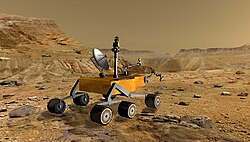483646main pia13398-4x3 1600-1200
The two main parts of the ChemCam laser instrument for NASA's Mars Science Laboratory mission are shown in this combined image.
On the left is the body unit, which goes inside the body of the mission's Mars rover, Curiosity. The mast unit on the right goes onto the rover's remote-sensing mast.
The mast unit, 37 centimeters (14.5 inches) long, contains ChemCam's laser, imager and telescope. It can be pointed at rock and soil targets in the vicinity of the rover from its position on top of the mast, 2 meters (6.6 feet) above the ground. Laser pulses vaporize a pinhead-size target up to 7 meters (32 feet) away, producing a flash of light from the material ionized by the laser. The telescope observes that flash of light.
An optical fiber from the mast unit delivers the telescope's observation to the body unit, which analyzes the light from the ionized target material to identify chemical elements in the target. The body unit is 20 centimeters (7.9 inches) long.
ChemCam was conceived, designed and built by a U.S.-French team led by Los Alamos National Laboratory in Los Alamos, N. M.; NASA's Jet Propulsion Laboratory in Pasadena, Calif.; the Centre National d'Études Spatiales (the French government space agency); and the Centre d'Étude Spatiale des Rayonnements at the Observatoire Midi-Pyrénées, Toulouse, France.
JPL, a division of the California Institute of Technology in Pasadena, manages the Mars Science Laboratory mission for the NASA Science Mission Directorate, Washington. This mission will land a rover named Curiosity on Mars in August 2012. Researchers will use the tools on the rover to study whether the landing region has had environmental conditions favorable for supporting microbial life and favorable for preserving clues about whether life existed.Relevante Bilder
Relevante Artikel
Mars Science LaboratoryMars Science Laboratory ist eine NASA-Mission im Rahmen des Flagship-Programms, die den Mars hinsichtlich seiner aktuellen und vergangenen Eignung als Biosphäre erforscht. Hierzu wurde auf der Oberfläche ein weitgehend autonomer Rover mit dem Namen Curiosity abgesetzt, der mit zehn Instrumenten zur Untersuchung von Gestein, Atmosphäre und Strahlung ausgerüstet ist. Zu deren Analyse kommen neben einer großen Zahl unterschiedlicher Spektrografen auch Kameras und meteorologische Instrumente zum Einsatz, welche die Messdaten für die Auswertung zur Erde schicken. Mit einer Masse von 900 kg und der Größe eines kompakten Kleinwagens war Curiosity bis zur Landung von Perseverance im Februar 2021 das schwerste von Menschen geschaffene Objekt auf der Marsoberfläche und löste die Viking-Tochtersonden mit je knapp 600 kg ab. .. weiterlesen










































